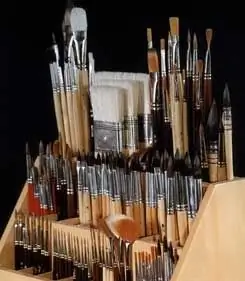How to understand a novice artist in the variety of brushes for creativity presented in our market. What are they in shape. What is it made of. Where can I apply this or that brush.

Domestic and foreign manufacturers delight us with such a wide range of brushes that it is very difficult for someone who has decided to take up a hobby to choose the right tool for himself. Brushes sometimes occupy entire departments in artist stores. How to choose and not spend a lot?
Let's start by classifying the brushes by shape. The simplest division is a flat and round brush.
In painting, use a flat brush when working with oil paints, tempera, acrylic, gouache. Round brushes are usually used in watercolor painting, as well as in the techniques listed above for drawing small elements.
How to determine the size. Very often, an aspiring artist receives a list from the teacher with the numbers of the brushes required for the class. In classic numbering, the brush number means its size in millimeters. For example, a # 3 round brush will have a diameter of 3mm. For flat brushes, the number is its width; flat brushes are usually numbered only with even numbers. But … there are exceptions to the rule. Firstly, each manufacturer has many series of brushes that differ slightly from each other, for example, the length of the handle or the length of the exhibition (this is actually what we paint with). In each series, the numbering can be completely arbitrary, so two similar brushes from different series with numbers 6 and 12 can have almost the same size. Most often, when recommending the number of the brush, the teacher means exactly its size in millimeters. This is what you should rely on when buying.
The brush can be made from natural hair of bristles, squirrels, columnar, cow's ear, sable, raccoon, wolf, etc. Synthetic hair brushes are now widely used. In some of their characteristics, they can surpass brushes made from natural hair, but in no case will they replace them.
So the bristles. Used for painting with oil, acrylic, tempera. The bristles can be stiff and softer depending on the quality of the hair. When choosing, be sure to pay attention to the ends of the hairs. They should have a natural thinning at the end, and in no case should they be cut off. The trimmed brush is only suitable for construction work or glue.
Columns. The king of the brushes. The most expensive material, but also the most durable, and suitable for almost all techniques from oil to watercolor. The hair of the column is not rigid, but elastic at the same time. The color is reddish brown.
Squirrel. Used mainly for watercolors. Holds a big drop. The color is black or reddish.
Cow ear. More coarse hair than squirrels, outwardly even looks like a column, but inferior to it in elasticity. It is most often used in children's art because of its low cost.
Sable. It looks like a column, rarely found among domestic brushes.
Raccoon. Also a rare guest on our showcases. Elastic coarse hair, closest to bristles. Often found in prefabricated calligraphy brushes.
Wolf. Used in calligraphy brushes.
Goat. White hair, similar in appearance to stubble, but very soft and not at all elastic. Goat hair holds a large drop, therefore it is used in calligraphy brushes. On its own it is good for some watercolor techniques and for painting fabrics.
When choosing a brush, carefully look at how it is assembled. All hairs should be tips up. The brush should not flake off. A professional artist store will always offer you a container of water to test how the brush is assembled. The sleeve should fit snugly on the handle.
Which handle to choose is a matter of taste, but from my own experience I will say that the best is an untreated beech handle.






